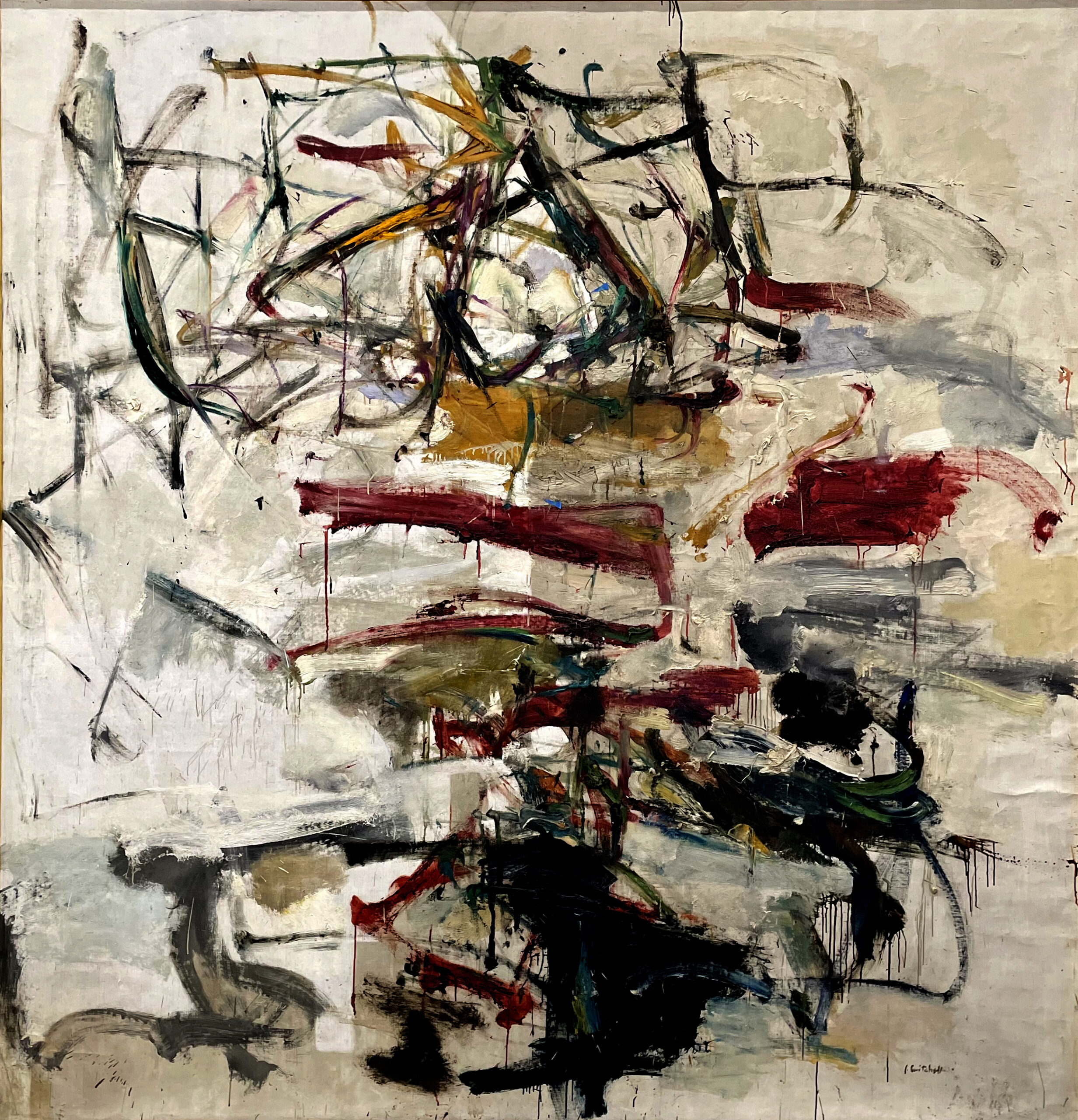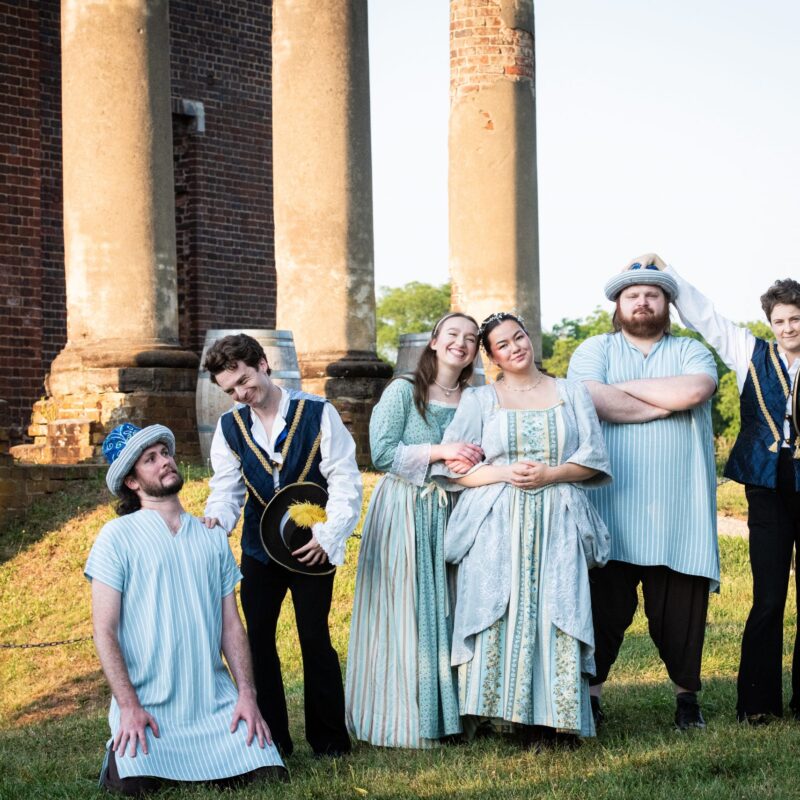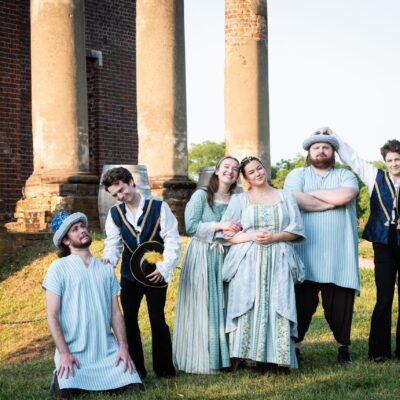In “Joan Mitchell: Uncovering 100 Years” at The Fralin Museum of Art at the University of Virginia, there’s a 1960 photo of the painter emphatically gesturing while standing in front of a large-scale canvas by Adolph Gottlieb. Mitchell seems comfortable in conversation with her art-world friends, hinting at the relationship she had with mid-20th-century galleries and their denizens.
The photo is next to five of Mitchell’s own paintings as part of a centennial celebration spread across about 70 museums in the U.S., France, and Australia. In Charlottesville, the show was put together by the curator M. Jordan Love, who says the exhibition’s as much about the pieces’ restoration as the paintings themselves.
Scott Nolley worked on cleaning a pair of Mitchell’s works in 2022 and 2023—live in The Fralin gallery with guests looking on. A video of that work, soldered together with an interview, is part of the show. The Hirshhorn Museum and Sculpture Garden’s head conservator did the cleaning independent of his day job, but still demurs at being the center of attention.
“It’s unique—it doesn’t happen all the time,” he says of plying his trade in front of an audience, work that he notes generally demands monastic solitude. “I think it’s to the credit of the university and the museum for allowing this to happen, to program very potently behind it and to maximize the public understanding of what it really takes to maintain a collection and to put these things on view, so they can be appreciated.”
Mitchell’s work, which can be viewed through July 20, is informed by a range of painterly ideas the artist gleaned through her travels in Mexico and France, and during her studies at the School of the Art Institute of Chicago. Some of her earliest works, dating to the 1940s, were figural while others touched on cubism—by then, an established form of abstraction championed by Pablo Picasso.
“She’s really looking at all of the work that’s come before her and then deciding for herself what she’s going to add to that conversation,” Love says of the Illinois-born artist’s development. “She’s not trying to probe her own psychology the way that Frida Kahlo was. She wasn’t trying to make larger comments on society the way that Diego Rivera was. She’s really just exploring form and color and layering.”
The five paintings—four oil-paint works and one watercolor—being shown at The Fralin were completed between 1953 and 1959, and are part of the museum’s Alan Groh-Buzz Miller Collection. The works reflect an artist with a steadfast and assured gestural style, relying on muted colors, sporadically highlighted by dashes of red, orange, or green.
Abstract painting can take sundry forms, but Mitchell’s interpretation of it, while connected to her contemporaries, displays a specific vision for the canvas.
“She was going kind of the very gestural [route]—thick, thick, layers of paint. Layers upon layers upon layers,” Love says. “She was very much in the Jackson Pollock camp.”
Nolley notes that “her paint sits up off the canvas measurably—to a half an inch,” and that Mitchell, like other abstract expressionists, added materials to her paints, changing their appearance and texture.
Among the paintings on display at UVA is “Neige,” a 1959 work whose title means snow in French. In the foreground, a flurry of squiggles are centered on the canvas—color peeking through the layers of paint. Love says the effect can be understood to be showing museumgoers what’s beneath the snow.
To prepare the paintings, Nolley used a water-based cleaning system and avoided chemical solvents. Those layers and layers of paint Mitchell applied, giving her pieces texture and the feeling of movement, affected how he approached the process. But the painting going from the Stable Gallery, which Groh ran, and into his home with Miller, then to The Fralin presented a unique scenario: It was clear the couple did some entertaining.
“[The paintings] were displayed in their home, and these guys—Alan and Buzz—were incredibly social,” Nolley says. “Typical of paintings and artworks that are displayed for an extended period of time in a domestic environment, they’re subject to exposures that are not commensurate with, for instance, a very privileged environment, like a gallery or a museum. So, if these paintings were hanging behind the sofa and there’s a continuous stream of cocktail parties, you can only imagine the level of exposure in a domestic environment, and how that contrasts to a Smithsonian museum.”
The other four Mitchell pieces that round out the show are all untitled, something that is common for her works. It was a tactic that had real purpose, says Love.
“A lot of abstract artists understood that each person was going to bring their own perspective to looking at the work of art, and might notice and be reminded of different things,” the curator says. “You allow people the freedom to kind of explore the forms themselves without saying, ‘Okay, well this is what I was thinking of. I was thinking of the beach.’”
Joan Mitchell, American, 1925-1992. In-process conservation treatment photo of “Neige,” 1959. Oil on canvas, 77 ½ x 74 ¾ in (196.9 x 189.9 cm). Collection of The Fralin Museum of Art at the University of Virginia. Bequest of Buzz Miller. The Alan Groh-Buzz Miller Collection, 1999.12.57. © Estate of Joan Mitchell. Photo: The Fralin Museum of Art at the University of Virginia.






